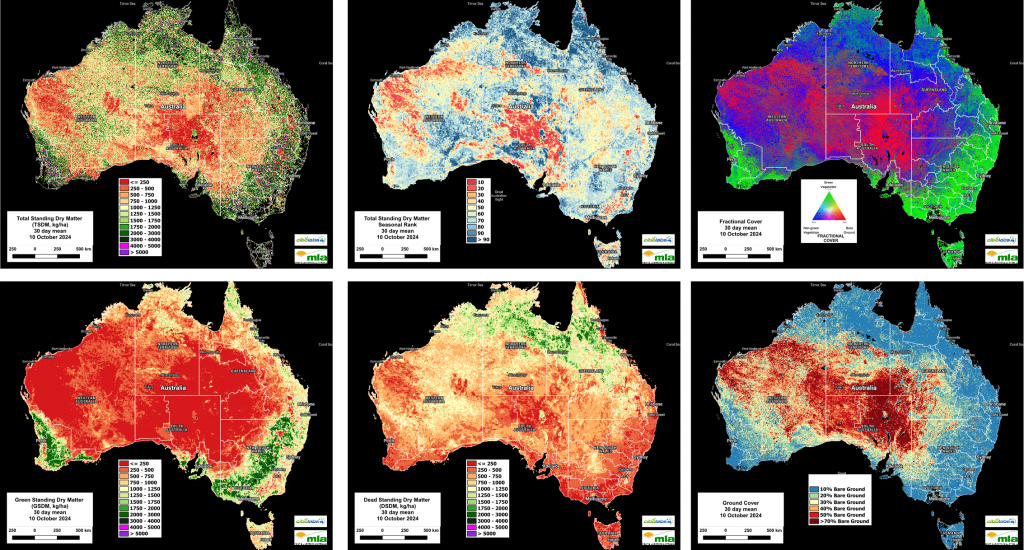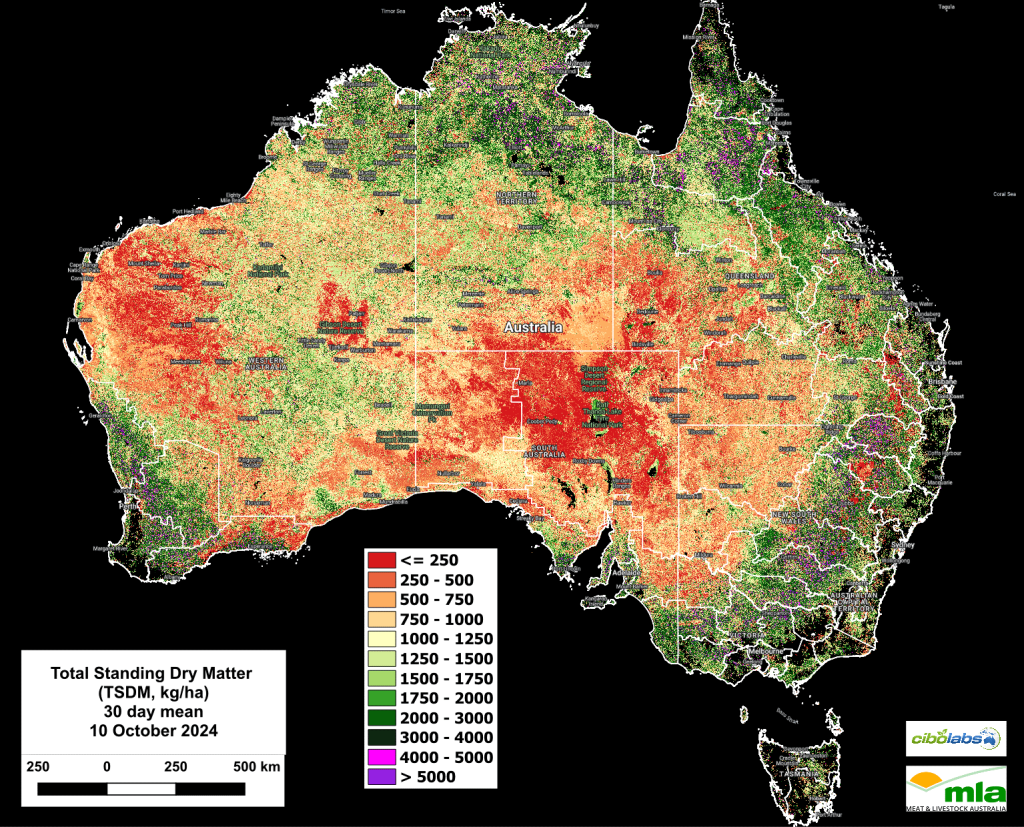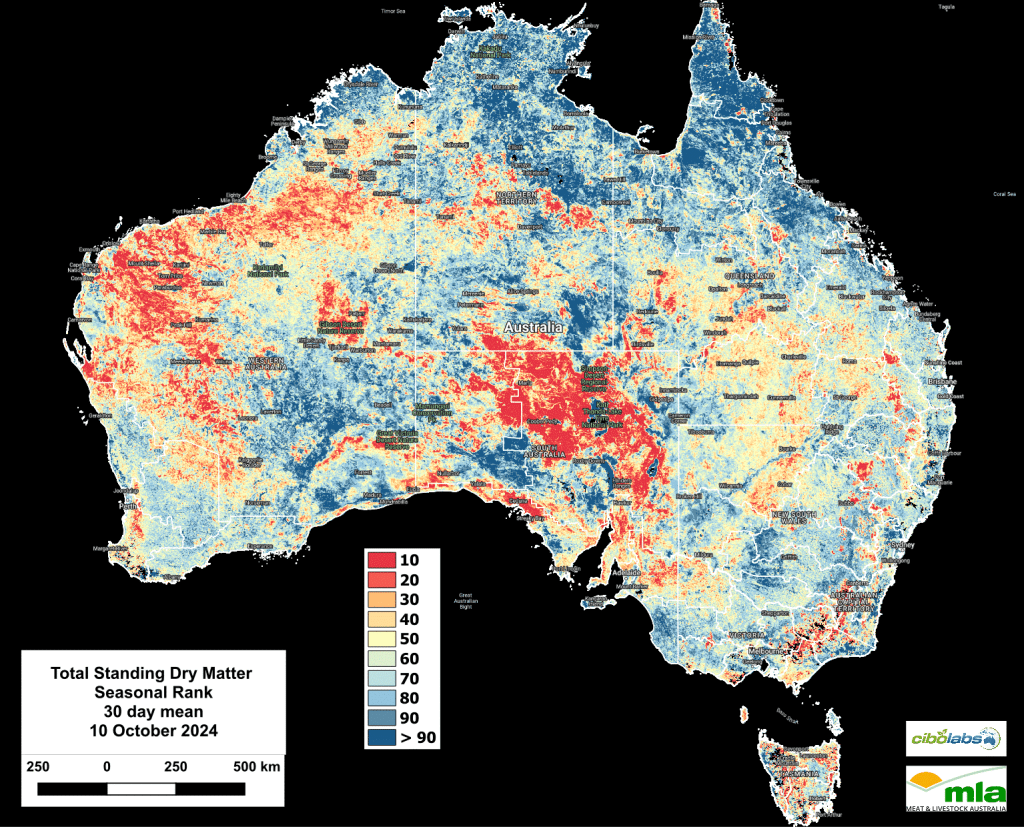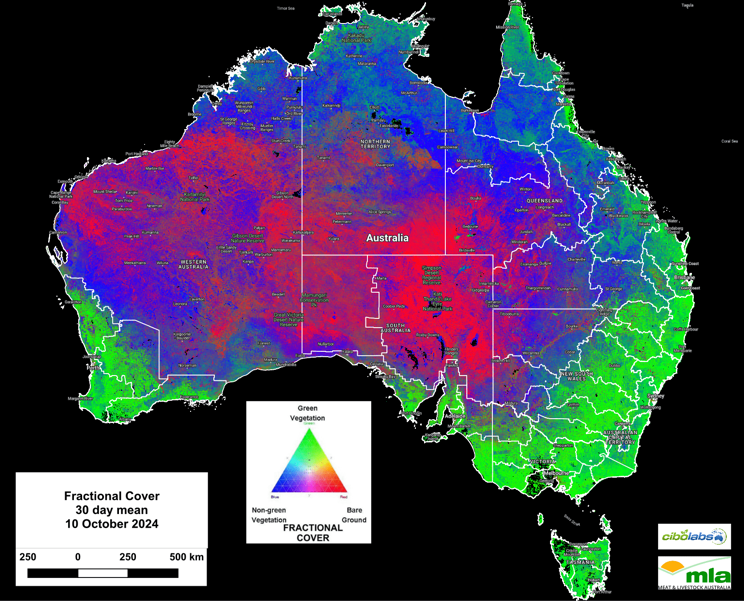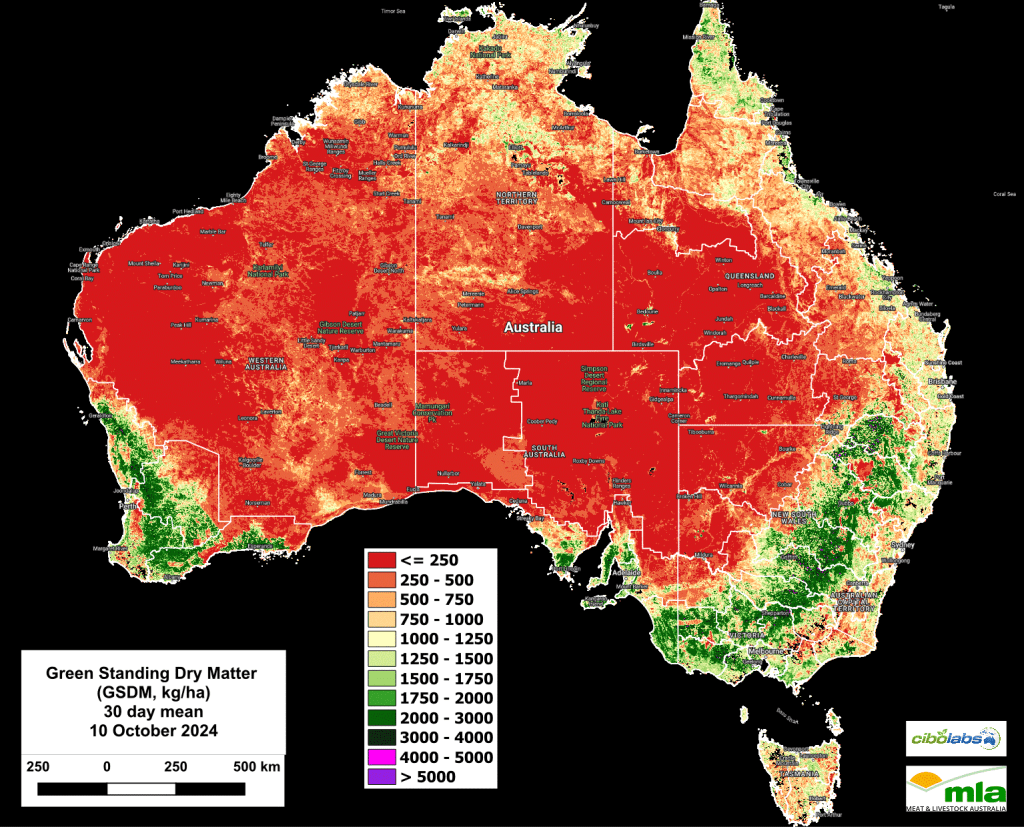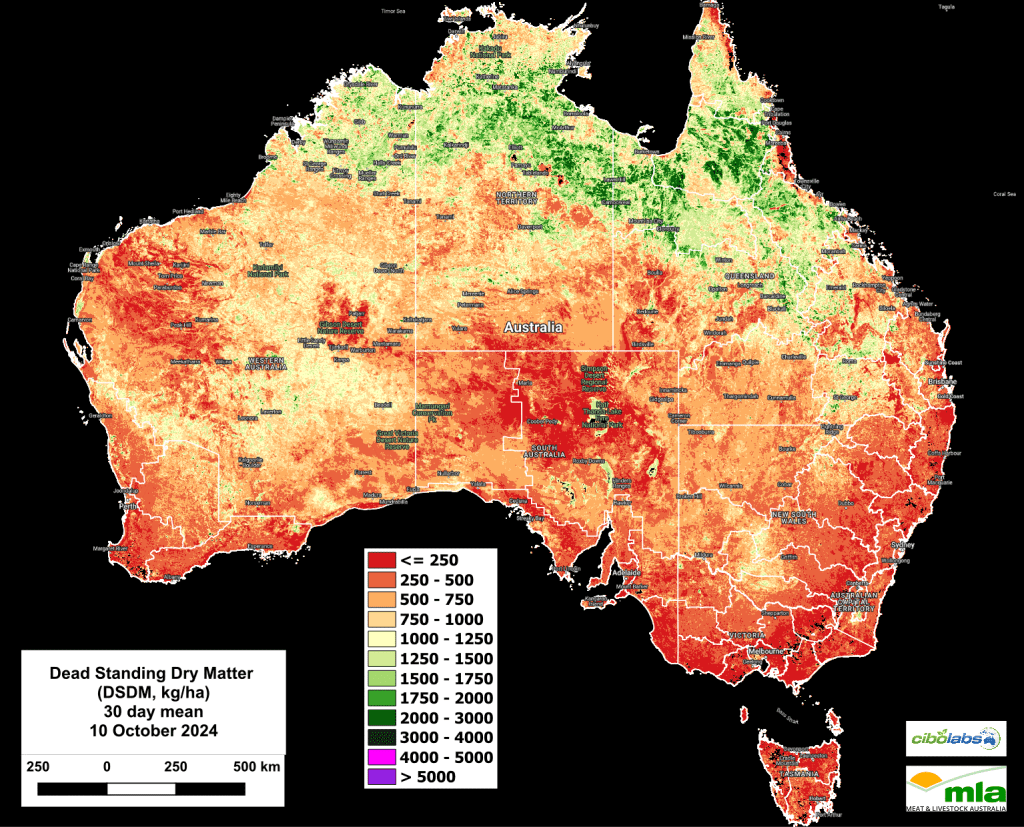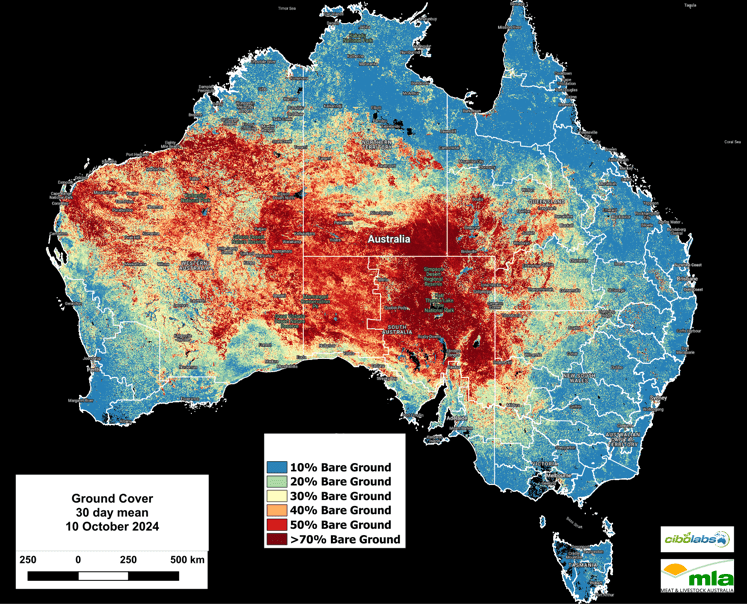Australia’s national feedbase in October 2024 reflects the seasonal shift from spring to summer, with varied rainfall impacting biomass across regions.
Parts of South Australia, Victoria, and southern Western Australia received low rainfall, generally between 5 to 25 millimetres, leading to below-average soil moisture.
This has challenged winter crop and pasture growth, with recent frost events in the south exacerbating conditions.
The pastoral zones in these areas have remained mostly dry, with sporadic rain insufficient to improve soil moisture significantly.

Imagery and analysis provided by CiboLabs
Total Standing Dry Matter
In eastern Australia, particularly in Queensland and NSW, slight increases in biomass are evident, with more areas exceeding 750 kg of total standing dry matter (TSDM) per hectare. Meanwhile, central regions continue to show low biomass levels, with TSDM mostly below 500 kg/ha, reflecting persistent dry conditions.
Southwestern WA has experienced minor vegetation expansion, particularly along coastal regions, moving into the 500–1000 kg/ha range, while the northern regions, including the Barkly Tablelands and Gulf, maintain relatively stable, moderate-to-low biomass levels.
These patterns indicate localized improvements in the east and southwest, while central and northern Australia remain largely unchanged.
Seasonal Comparison Total Standing Dry Matter
Northern Australia, including areas like the Barkly Tablelands, Gulf, Cape York, and northeast Queensland, saw TSDM levels shift from above average in September to closer to average in October (Image 2).
New South Wales, central Victoria, and Tasmania maintained near-average levels, with minor fluctuations.
Northeast Tasmania and the Bass Strait Islands continued to experience below-average conditions, with little change over this period. Southern Australia, the Pilbara, and the Gascoyne regions in WA have consistently recorded below-average TSDM, reflecting ongoing dry conditions.
Fractional Cover (Growth)
Fractional cover data highlights consistent vegetation growth in eastern NSW, Victoria, and Tasmania, indicated by bright green areas on the map (Image 3).
This growth is expected to improve biomass levels despite some regions still showing below-average TSDM.
In southwestern WA, vegetation has extended from Geraldton southeast to the coast, reflecting steady growth.
The latest October data suggests slight expansion in green areas across these regions, indicating progressive growth, though central and arid zones in Australia continue to display limited vegetation dominated by bare ground and non-green cover.
Green Total Standing Dry Matter
Green standing dry matter (GSDM) levels (Image 4) are highest in NSW and Victoria, with biomass exceeding 2000 kg DM/ha from the Border Rivers through to the southwest coast.
Cape York and northern Queensland show moderate GSDM levels between 1250 and 2000 kg/ha.
Southwestern WA also shows recent increases in GSDM, while central and northern Australia maintain low vegetation growth.
Additionally, southeastern NSW and Tasmania have high biomass concentrations, indicating active growth, though generally lower than the main southern cropping zones.
Dead Standing Dry Matter
Dead standing dry matter (DSDM) (Image 5) remains high across northern Australia, particularly in the eastern Kimberley, Northern Territory, and central Queensland, with values exceeding 1750 kg DM/ha.
This level of dead feed is persistent across large areas in the north.
In the southern states, however, DSDM remains sparse, mostly below 750 kg DM/ha, with minimal increase observed between dates. High DSDM areas in the north and central regions remain largely unchanged, suggesting stable dry matter conditions in these areas.
Monthly Ground Cover levels
Ground cover (Image 6) remained stable across much of Australia, with notable trends in specific regions.
Central and northern areas, particularly in Queensland and the Northern Territory, display extensive bare ground coverage, with many areas showing over 50% bare ground.
Southeastern regions, including NSW and Victoria, retained better vegetation density, with less than 20% bare ground.
Southwestern Western Australia showed slight variations but generally maintained ground cover.
Central Australia, however, consistently exhibited sparse vegetation, indicating persistent dry conditions and limited new growth. Overall, minimal changes were observed in ground cover over these dates.
For more localised information including regional level overviews, users are encouraged to explore the Cibo Labs Regional Comparison. This tool provides regional data that may show the impact of localised weather or fire events. A further level of detail for individual properties is available for users who have created an Australian Feedbase Monitor account, which can be accessed both through the MyMLA portal or through the Cibo Labs website. These tools enable land managers to make data-informed decisions tailored to their unique feedbase conditions and needs.
The Cibo Labs National Comparison can be used to freely access these layers (https://www.cibolabs.com.au/products/national-comparsion/) to view the most recent images from a national, state or catchment level.
This tool can complement the Australian Feedbase Monitor which can also be created within the Cibo Labs Web Site www.cibolabs.com.au
